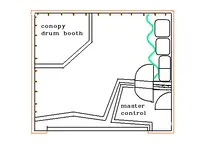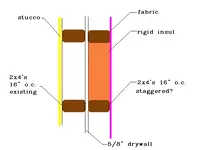C
casenpoint
New member
Hey, I found this product by johnson manville called spinglass. Is it really as dense as 703 by owens corning. And is it aroud the same price $1.29 a square foot for 2 inch 2' by 4'. This is the price I was qouted by the sales rep. And are they really exactely 2 feet wide if so should I space my 2 by 4s at 24 3/4" apart on center?
This is not a double wall construction but the garage door opening will be sealed off in front of the steel door. Get rid of the steel door? Hmm. Then another wall will follow behind that. I've got floor plans in some software and will try and convert them.
The control room will be on the oppposite side the drums with a double wall construction.
Most of the dense stuff will be in and around the drum booth which will have a canopy whith a ceiling height of around 6 feet running all the way to the garages ceiling with a facade running around the opening which will be open to the rest of the room. The drum booth will be built in a corner.
I need help with finding insulation at a fair price in and around Los Angeles. The over all construction is in the works and any input would be appreciated.
This is not a double wall construction but the garage door opening will be sealed off in front of the steel door. Get rid of the steel door? Hmm. Then another wall will follow behind that. I've got floor plans in some software and will try and convert them.
The control room will be on the oppposite side the drums with a double wall construction.
Most of the dense stuff will be in and around the drum booth which will have a canopy whith a ceiling height of around 6 feet running all the way to the garages ceiling with a facade running around the opening which will be open to the rest of the room. The drum booth will be built in a corner.
I need help with finding insulation at a fair price in and around Los Angeles. The over all construction is in the works and any input would be appreciated.



